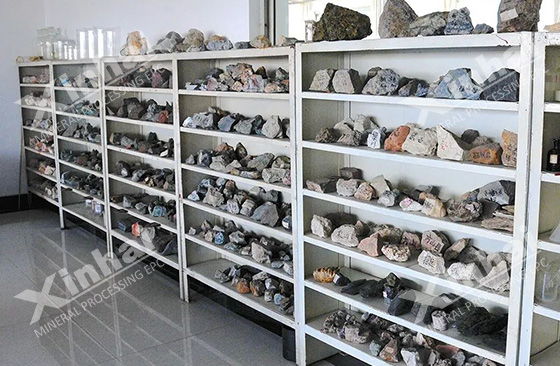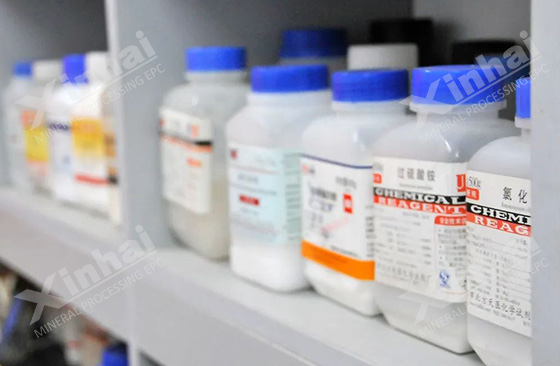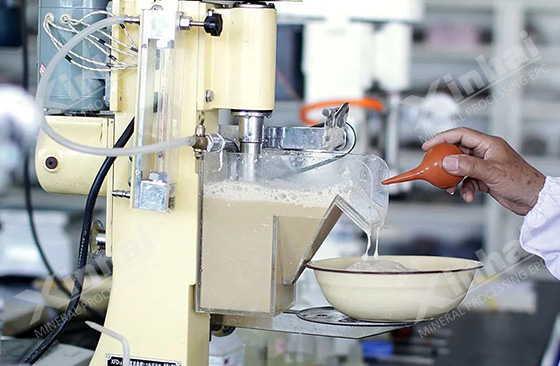
In the flotation technology, it is necessary to consider not only the selection of flotation agent, dosage, dosing time, but also the charging capacity, pulp concentration, PH value and other issues. In order to determine the appropriate flotation process flow, equipment and reagent before the formal production, improve the field production indicators, improve the mineral recovery rate, and reduce the processing cost, it needs to be carried out. Flotation test mainly includes three steps:
Firstly, according to the ore samples sent by the customer, the ore properties are studied, and the flotation test scheme is preliminarily drawn up based on the field experience and professional knowledge.

1.The preparation of ore samples
The particle size of flotation test is generally required to be less than 1-3mm, and the particle size of this range is suitable for the ore feeding particle size used in flotation test, which can also ensure the representativeness of samples. Therefore, the ore sample is firstly broken to make the sample reach the required particle size. The samples after crushing are evenly mixed and divided into several samples, with the content of each sample being about 500-1000g. For low-grade ores, the content of each sample can be increased to 3000g.
Attention should be paid to the prevention of sample contamination during sample preparation and the oxygen isolation measures for easily oxidized minerals.

2.The preparation of flotation reagents
This is especially important during flotation, and it needs to be prepared in advance and well preserved to keep it alive. Always check to see if the agent is within the shelf life to make sure it is available, and then store it in a dry container and in the shade before use.
3.The preparation of grinding machines
The laboratory should be equipped with a variety of mills of different sizes to ensure that different doses of samples can be ground.
4.The preparation of flotation machines
The laboratory basically chooses the small mechanical stirring type flotation machine. Several small size single slot flotation machine can be selected, such as 0.5L, 0.75L, 1.0L, 1.5L, 3.0L.
5.The water of flotation
Generally, the laboratory USES the tap water in the area for experiments. After determining the main process conditions, the water source that may be used by the concentrator in the future will be checked. To make the above basic preparations, clean instruments and tools should be prepared in advance.
Flotation test mainly includes pre-test, condition test, closed - circuit test, intermediate test and industrial test. The main purpose is to determine the ore flotation process and indicators, and finally determine the best flotation conditions.
Flotation test process generally includes grinding, slurry mixing, flotation (scraping) and target product processing steps.
1.Grinding
First, empty running the grinding machine, cleaning. The grinding operation is then carried out. In this process, it is necessary to pay attention to whether the grinding speed is normal, whether the operation is smooth, whether the grinding sound is normal and so on, and accurately record the grinding time. At the end of grinding, the slurry shall be flushed into the receiving vessel with clean water. After all is poured out, clean the mill.

2.Mixing the slurry
A certain amount of flotation agents were added to the stirred tank in batches for mixing and stirring, so as to promote the suspension of ore particles and even dispersion in the flotation tank, promote the air dispersion, make the ore particles in full contact with bubbles, and ensure the flotation effect.
3.Flotation and blow the foams
Ensure that the volume of gas is stable and constant, continue to inflate stirring. Adjust foaming agent dosage, pulp page height, stable scraping out a certain amount of bubbles in high quality. The foam layer thickness of the laboratory flotation machine is generally controlled at 25-50 mm. During the operation process, due to the continuous scraping of foam, the grout level of the tank continues to decline. At this point, water is added without affecting the PH of the slurry to ensure that the foam can be continuously scraped. The pH and temperature of the slurry must be measured and recorded at the beginning and end of the foaming process in preparation for later analysis. After flotation, pour out the tailings slurry and clean the flotation machine.
4.Target product treatment
The pulp discharged by the flotation machine needs to be dehydrated and dried. After drying, the product should be weighed and sampled for chemical analysis.
So that's the whole process of the flotation test. However, the flotation test is very necessary to ensure the design of a reasonable flotation process and determine a reasonable index.
To find out more about our products and solutions, please fill out the form below and one of our experts will get back to you shortly.